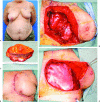Stabilization of the chest wall: autologous and alloplastic reconstructions
- PMID: 22294941
- PMCID: PMC3140239
- DOI: 10.1055/s-0031-1275169
Stabilization of the chest wall: autologous and alloplastic reconstructions
Abstract
The goals of chest wall stabilization include maintenance of a rigid airtight cavity, protection of the thoracic and abdominal contents, optimization of respiration, and, whenever possible, an aesthetic reconstruction. Evidence suggests that bony fixation results in reduced ventilator dependence, a shorter overall hospital stay, and improved upper extremity function. We prefer to accomplish this with autologous tissue alone (such as the pectoralis major, latissimus dorsi, or rectus abdominus muscle flaps) for small to moderate defects. En bloc resection of defects larger than 5 cm or containing four or more ribs will likely benefit from chest wall stabilization. For patients previously treated with radiation, even larger defects may be tolerated owing to fibrosis. For these larger defects, methyl methacrylate composite meshes are used and covered with vascularized tissue. Contaminated wounds are generally reconstructed with bioprosthetic mesh rather than synthetic mesh. Using these principles, the reconstructive plastic surgeon can devise a comprehensive and safe plan to repair tremendous defects of the chest wall.
Keywords: Chest wall; alloplastic; autologous; reconstruction; stabilization.
Figures



References
-
- Parham D W. Thoracic resection for tumors growing from the bony chest wall. Trans South Surg Assoc. 1899;2:223–363.
-
- Fell G E. Forced respiration. JAMA. 1891;16:325–330.
-
- O'Dwyer J. Fifty cases of croup in private practice treated by intubation of the larynx with a description of the method and of the dangers incident thereto. Med Rec. 1887;32:557–561.
-
- Kroll S S, Walsh G, Ryan B, King R C. Risks and benefits of using Marlex mesh in chest wall reconstruction. Ann Plast Surg. 1993;31:303–306. - PubMed
-
- Netscher D T, Eladoumikdachi F, McHugh P M, Thornby J, Soltero E. Sternal wound debridement and muscle flap reconstruction: functional implications. Ann Plast Surg. 2003;51:115–122. discussion 123–125. - PubMed
LinkOut - more resources
Full Text Sources
Research Materials

